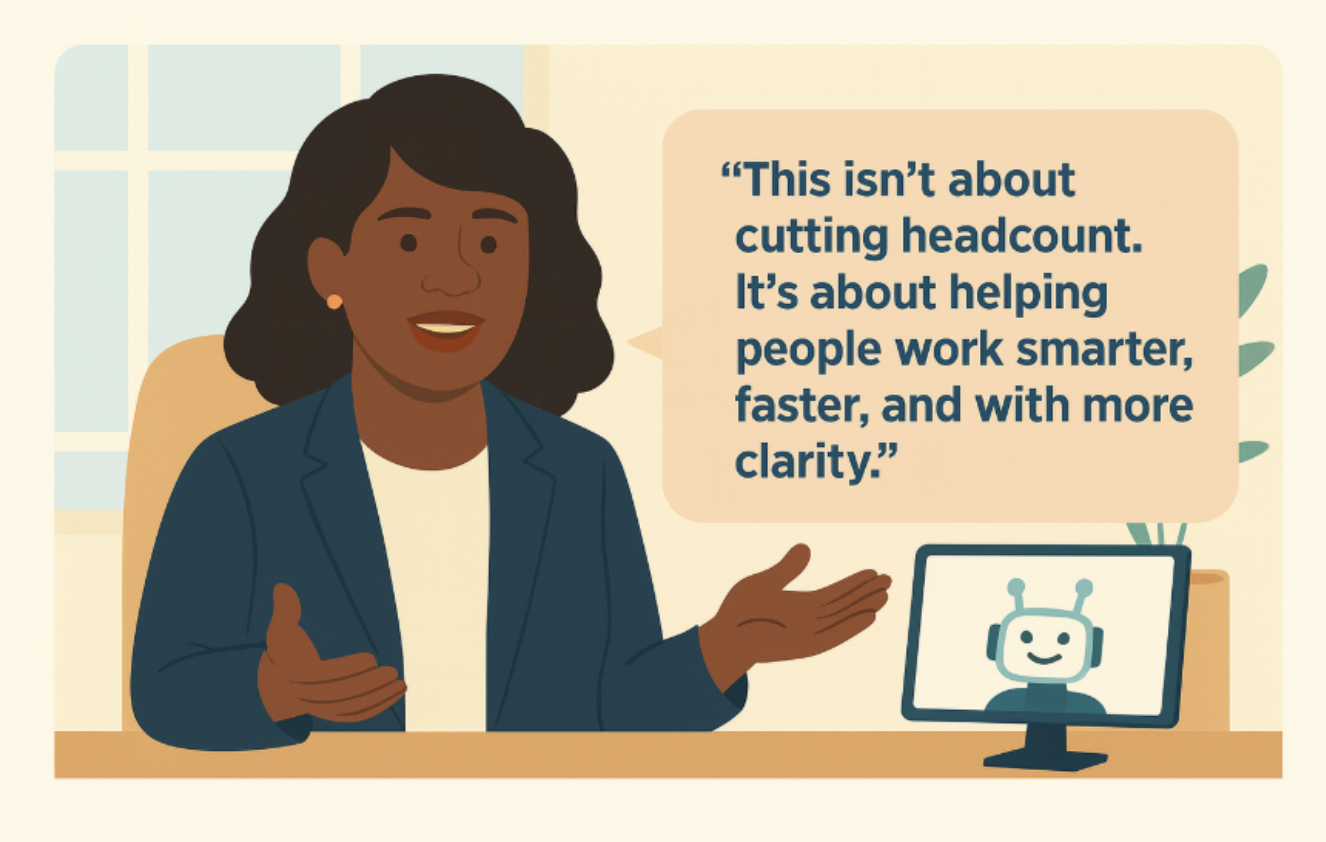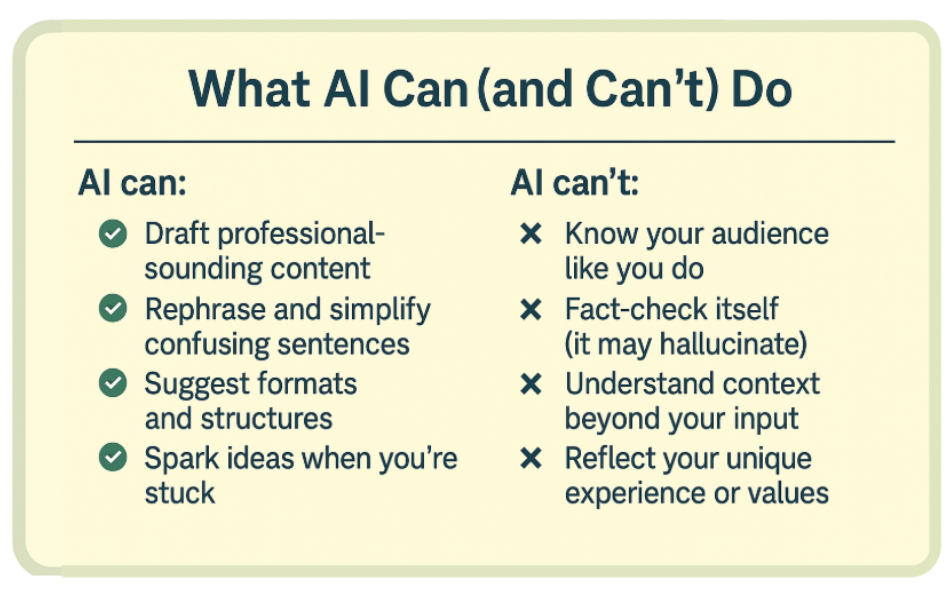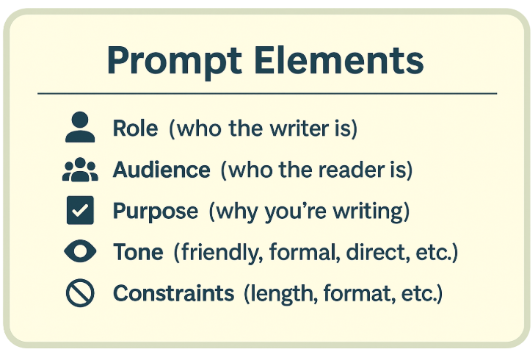Write (with Gen Ai)
Use the Tool; Keep the Human
Story
JP Morgan Chase’s Real-World Advantage
In 2024, JPMorgan Chase gave over 200,000 employees access to a proprietary generative AI platform called IndexGPT. But the goal wasn’t to replace employees—it was to empower them. Marketing and operations professionals began using the tool to organize client reports, simplify regulatory updates, and sharpen client-facing messaging.
As one executive shared in an interview, “This isn’t about cutting headcount. It’s about helping people work smarter, faster, and with more clarity.”
The results? Increased productivity, faster internal reviews, and clearer communication with stakeholders. Professionals who adopted the tool early began standing out—not because AI replaced their skills, but because they used it to amplify their work.

Main Idea
AI Can Enhance Your Writing—But it Can’t Think for You
Generative AI tools like ChatGPT, Claude, and Microsoft Copilot are changing the way people write. They can help brainstorm, rephrase, summarize, and revise. But they don’t replace the need to understand the task and formulate a clear message.
This chapter helps you use AI as a business tool—one that boosts productivity without replacing your judgment.
“Generative AI won’t take your job—but someone who knows how to use it better than you will.”
Agenda
What You’ll Learn in This Chapter
- Use AI to enhance your business writing
- Write effective prompts using chain-of-thought reasoning
- Collaborate with AI on storytelling while avoiding generic traps
- Stay ethical and protect your voice and credibility
Reasons
Getting the Best from AI Without Losing Your Voice
1. Use AI to Enhance Your Writing
Do the work to become absolutely clear on your message before you engage with AI. This ensures that you are driving the creative process. Once clear, use AI to assist with idea generation, structure, tone-checking, or revising.

Rely on your brain for clarity, tone, and accuracy. Use AI for productivity in items like:
- Drafting a complicated professional email or memo
- Condensing something verbose
- Adjusting your draft to a more appropriate tone
But if you let it do all the work, your writing will sound generic. Worse, you won’t develop the communication skills real employers value most.
2. Master the Art of Prompting
Prompting is giving instructions to an AI model. But highly effective prompts are precise, specific, and well-structured.

Example 1: Weak Prompt
“Write an email to reschedule a meeting with a client.”
Example 2: Strong Prompt
“Act as a sales team lead writing to a client who missed a meeting. Write a friendly, professional email that reschedules the meeting and reaffirms our interest in working together. Keep it under 150 words.”
Practice building prompts like a manager assigning a task. Clear instructions with adequate context and step-by-step directions yield better results. For complicated projects, use chain-of-thought prompting.
Example 1: Brain-dump Prompt
“Summarize this article, write an email about it, make it sound professional, fix the tone, and also suggest some catchy subject lines.”

Example 2: Chain-of-thought Prompt
“We’re going to prepare a summary for Global Reach, an important new client."
- Step 1: Summarize the article I’ll upload into three bullet points for a business audience.
- Step 2: Based on that summary, write a short email that explains the key points to a supply chain client of ours, highlighting how our services can help them.
- Step 3: Suggest three possible subject lines for the email.
At this point, upload the article you referred to in your prompt.
3. Storytelling with Generative AI
AI’s training on fiction makes it prone to produce dramatic, over-the-top intros—like “Imagine you’re a sea captain navigating stormy waters…” Avoid the ‘Sea Captain’ Trap. You’re writing business insights, not movie trailers.
Better approach: Collaborate with AI. Don’t let it lead.
- “Give me real-world examples of companies solving this problem in the last two years.”
- “Here’s a true story about our client. Help me frame it around opportunity cost.”
- “Suggest three ways to introduce a business case without sounding fictional.”
Use AI to structure or expand your story—but supply the substance yourself.
“AI can help tell the story—but only you know what’s worth telling.”
4. Stay Ethical—and Be Wise
Generative AI isn’t magic. It’s trained on public data, which means

Use your judgment. If you use AI to help write something:

Watch out for the following:

Also, don’t upload private or confidential info into certain AI systems—your data may be stored or used for training.
Someday our use of AI will be assumed, but during this transition period, cite your use of AI transparently to boost your credibility and protect you from accusations of cheating.

For More Information READ:
Mozilla Foundation “AI & User Privacy”“Generative AI can speed up your writing—but it can’t replace your judgment.”
Task
Use AI Wisely
As you prepare a research-based business article or write professional messages, try this:
- Use AI to help you brainstorm or revise one of your writing assignments. Then reflect:
- What did the AI get right?
- What did you need to change?
- What did you gain from using AI? What did you lose?
- Did using AI make your thinking better, or just faster?
Just like JPMorgan’s analysts, your edge isn’t in replacing your writing with AI—it’s in using it well to create clearer, more strategic business communication.
As you practice writing, think of AI as a tool in your toolbox. But the architect? That’s still you.